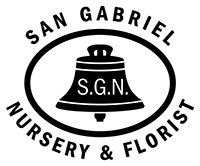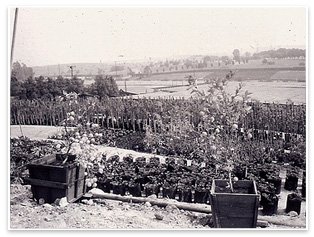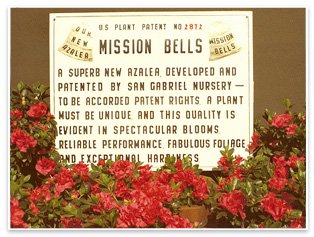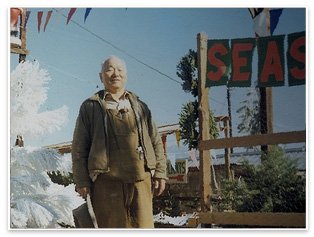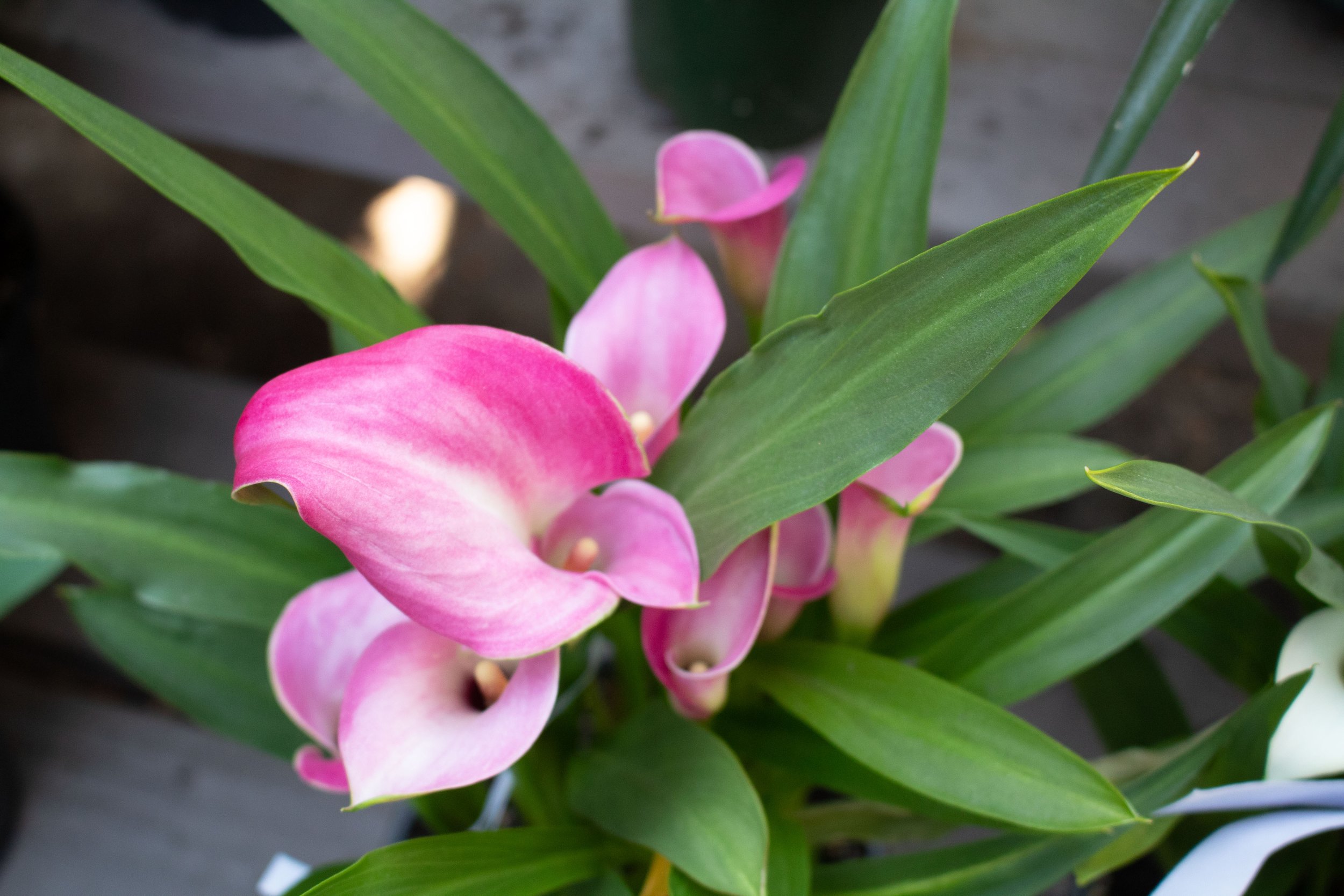
About
San Gabriel Nursery & Florist is one of Southern California's largest and most complete garden centers. We have been family-owned and operated since the nursery was founded in 1923. Our many years of experience include extensive knowledge about the plants, climate and growing conditions conducive to Southern California.

Our first location on San Gabriel Boulevard taken 1938
OUR COMPANY HISTORY
INTRODUCTION
As one of the oldest and largest nurseries and florists in Southern California, the San Gabriel Nursery & Florist has served the gardening needs of the area’s residents for over 80 years. The company was founded by Fred and Mitoko Yoshimura in 1923 as Mission Nursery. This nursery was originally located at 735 South San Gabriel Boulevard, across the street from its present location. The San Gabriel Nursery & Florist continues to be a family operated business that was incorporated under its present name in 1955. The nursery continues to maintain one of the largest and most complete selections of quality plant specimens at a single location. Our many years of experience include extensive knowledge about the plants, climate and growing conditions conducive to Southern California. The nursery is also known as one of the best sources for rare and “hard to find” plants.
THE FOUNDERS
Fred W. Yoshimura was born in Yamaguchi, Japan on April 2, 1895. When he was 21 years old, he came to the United States with the dream of becoming a successful businessman in order to help support his family in Japan. He arrived in San Francisco, California in 1917, when he was 21 years old. In 1922, Mr. Yoshimura came to San Gabriel where he stayed at a boarding house and learned how to garden. During the early 1920’s, many large estates were being constructed in San Marino and Pasadena by individuals who were attracted to the arid climate. Mr. Yoshimura busily set about landscaping and gardening a good number of these new residences. At the time, irrigation systems were a novelty item that only the wealthy could afford. Mr. Yoshimura became one of the pioneers of sprinkler system installation in this area. From his various gardening jobs, Mr. Yoshimura obtained cuttings that he used to propagate his own plants. After saving some money from his gardening jobs, he was able to lease a small parcel of land and start his own nursery which he called Mission Nursery.
While gardening at a home in South Pasadena, he met Mitoko Naito who was a maid there. Mitoko was born on April 10, 1899, in Hiroshima, Japan and traveled by boat to the United States when she was only 15 years old. She came to work for a family in South Pasadena who taught her domestic skills, including how to cook. While working there, she also attended school where she learned how to read and write in English. Fred and Mitoko married in South Pasadena on February 29, 1924, and had four children: Hayao, Raymond, Florence and Margie. All of them eventually contributed to the nursery’s expansion into other areas.
According to Mitoko, she started working at the nursery the day after she was married. With very little knowledge, she set about planting and transplanting the many cuttings Mr. Yoshimura brought home from gardening. Mrs. Yoshimura also learned about azalea planting from a worker who was employed at Coolidge Nursery in Pasadena. Azaleas and camellias have proven to grow well in this area and have continued to be specialties of the San Gabriel Nursery. Another of Mrs. Yoshimura’s responsibilities was to feed and care for their horses. Mr. Yoshimura used the horses to travel to his gardening jobs and as work horses. The horses were used to plow up the ground at the large estates that he landscaped.
ONE OF THE FIRST FLORISTS
Mrs. Yoshimura also started one of the first florists in San Gabriel. Her customers came from all parts of the San Gabriel Valley since it was one of the few florists in the area for a number of years. Ironically, Mrs. Yoshimura started a flower shop at the suggestion of one of her customers, who also offered to teach her the basics of floral arranging since she had no prior experience. Mrs. Yoshimura’s further knowledge of flower arranging came from self-training and experience. She learned how to make different types of arrangements, hand bouquets, corsages, funeral wreaths and sprays. She also made floral wreaths for her customers who rode their horses in the Pasadena Rose Parade.
1930’S PROSPERING YEARS
By the early 1930’s, Mr. and Mrs. Yoshimura employed over 60 people, and the business was prospering. The nursery stock included azaleas, camellias, roses, ornamental shrubs, bonsai, trees, flowering pot plants and Japanese garden ornaments. In addition to sprinkler system installation, Mr. Yoshimura’s landscaping expertise included rock gardens and fish ponds. Mission Nursery also had two large fish ponds that he landscaped as well. The Japanese garden ornaments that were for sale were either imported from Japan or made by an Englishman (name unknown) whom Mr. Yoshimura employed. This Englishman trained in Yokohama, Japan, and he made many of the stone lanterns and benches that were sold at the nursery.
The Yoshimura’s were dedicated to promoting goodwill between Japanese-Americans and the surrounding community. Mr. Yoshimura was actively involved in many civic events, such as participating in the San Gabriel Mission’s annual parade in which Mission Nursery’s “float” (a flatbed truck covered with plants and flowers) was said to have often won first prize. In 1932, he became a member of the San Gabriel Chamber of Commerce and was well known by many San Gabriel businessmen. He was also a leader of the Japanese American community. He tried to help bring a better understanding of the Japanese culture to help the people be accepted into American society. In addition, while he was President of the Nurserymen’s Association, he helped organize the delivery of many truckloads of nursery stock that were donated to various United States military bases in California.
WORLD WAR II AND INTERNMENT
Immediately after the bombing of Pearl Harbor, Japanese community leaders were targeted by United States authorities and were considered enemy aliens. Regardless of his good standing with the local community, Mr. Yoshimura was picked up by agents from the Federal Bureau of Investigation the day after the attack on Pearl Harbor. He was then interrogated and detained for many months. Mrs. Yoshimura did not know where her husband had been taken or when she would see him again. In the meantime, the family received a federal government notice informing them to prepare for an indefinite internment at a remote relocation center. They were given short notice to make arrangements for their business and property. Moreover, Mrs. Yoshimura had to make these arrangements by herself. Their primary concern was for the bank loans that needed to be repaid in order to avoid the forfeiture of the nursery’s valuable inventory and property.
According to Mrs. Yoshimura, as soon as the notice was posted, she was approached by several individuals who offered to buy the nursery for only a fraction of its value, since it was known that the business would most likely have to be sold. Mrs. Yoshimura did not succumb to the pressure to sell at the first opportunity like many of the Japanese people who were left in similar situations. Fortunately, the Yoshimuras were acquainted with E. Manchester Boddy, publisher of the Los Angeles Daily News, from his visits to the nursery to find plants for his estate in La Canada which is now known as Descanso Gardens. Mr. Boddy purchased the business, including the nursery stock, from Mitoko at a fair enough price that allowed her to pay off their loans and also give a small bonus to each of her workers. Mr. Boddy also took over the lease on the nursery’s property and continued to operate the business while the Yoshimuras were interned at a relocation camp.
In April 1942, Mrs. Yoshimura and her children were sent to a relocation camp in Gila River, Arizona. Hayao was drafted and served in the United States Army during the war. Mr. Yoshimura was eventually allowed to join his family in the summer of 1942. Compared to many of the other Japanese community leaders that were detained by the FBI, Mr. Yoshimura was released fairly soon because of his earlier efforts in showing support for the United States and his good standing with the local community. At Mrs. Yoshimura’s request, many of the San Gabriel community leaders signed documents attesting to her husband’s good character.
While in camp, Mrs. Yoshimura was paid by the government to help run the flower shop. She helped prepare the floral arrangements for weddings, funerals, and other social events. On one occasion, Mrs. Yoshimura prepared the presentation bouquet that was given to Eleanor Roosevelt when she visited the camp. Mr. Yoshimura was in charge of growing the cut-flowers and the plants that were used in the flower shop and around the camp. In addition, Mr. Boddy paid for the business in installments and as a result, the Yoshimuras received checks from him while they were in camp. Unlike many of the Japanese who basically lost everything when they were interned, these payments provided the Yoshimuras with some capital to start over once the war ended. Gene Perez, a long time friend and employee who worked with Mr. Yoshimura when he started the nursery, looked after the Yoshimura's personal belongings until they were able to return to San Gabriel.
RETURNING HOME AND STARTING OVER
After the war ended in 1945, the Yoshimuras returned to San Gabriel. Since the business had been sold to Mr. Boddy, they had to find a new way to earn a living. They were fortunate to be able to start their new company, the San Gabriel Nursery & Florist, at its present site that is located across the street from their old address. Around that time, Mr. Boddy closed the old nursery, and took all of the stock to his estate where he started his own wholesale camellia nursery and cut flower business. Many of the camellias, azaleas, rhododendrons and Japanese lanterns found at Descanso Gardens today originally came from the Mission Nursery inventory that Boddy purchased from the Yoshimuras.
The Yoshimuras were fortunate to have known many nice people who were eager to help them rebuild their business and their lives. The Yoshimuras, in turn, helped many of the Japanese families they had met in camp by providing them with food and a place to stay until they were able to earn a living on their own. They even had to pitch up tents at the nursery to accommodate the families that were staying with them. Mr. Yoshimura and his sons started gardening again to obtain the cuttings to build up the nursery’s stock. In addition, since shrubs and other plants take several years to grow to a proper size for sale, they planted pansies for a quick profit. The present site of the nursery’s retail store was where the pansy fields were located. Unlike the convenient plastic trays that pansies are sold in today, employees had to dig up the planted pansies as the customers would point out the ones they wanted to purchase. Several family members recall having to run back and forth as discerning customers would look for the best pansies.
EXPANSION: WHOLESALE GROWING, THE FLOWER MARKET, “THE RANCH” AND “THE NEW RANCH”
Raymond served in the United States Army in 1946 and graduated with honors from Ohio State University. While in college, Raymond became reacquainted with Ichiro “Jim” Yoshihashi who he knew earlier from camp. Ichiro was also a horticulture major, and Raymond suggested that he go to work for his father in San Gabriel. Ichiro started working at the San Gabriel Nursery in 1949. During the 1950’s, with the help of Raymond and Ichiro, the nursery’s wholesale business started to expand. Seven greenhouses were constructed, and they started to sell a diverse selection of plants to nurseries and florists throughout Southern California. Since the 1950’s, the company has also maintained a wholesale store at the Southern California Flower Growers market. The San Gabriel Nursery & Florist has long been a well-known source for florists, nurseries and interior decorators looking for azaleas, green plants, gardenias, pachiras, bonsai, hydrangeas, roses and poinsettias.
After the war, Mr. Yoshimura also began growing and selling cut-flowers at 2015 Potrero Grande in Monterey Park. Although cut-flowers are no longer being grown there, the San Gabriel Nursery & Florist continues to have a busy retail shop at this location. After the establishment of the Resurrection Cemetary, the Potrero Grande growing grounds turned out to be an ideal location for selling hand bouquets and other florist items. In addition, there are now approximately ten acres of nursery stock being grown at “The Ranch” and an additional eight acres being grown at the “New Ranch” which is located in Rosemead.
SAN GABRIEL NURSERY PLANT INTRODUCTIONS
Over the years, Raymond started hybridizing azaleas and has created several new varieties. The most popular SGN introduction is the “Mission Bell” azalea which was named after its characteristic bell-shaped flower and its origin in San Gabriel, “The City with a Mission.”
In order to compete with the larger wholesale nurseries, the San Gabriel Nursery has diversified its selection of wholesale inventory by growing new and more unusual varieties of plants. The most popular SGN introductions to be grown commercially in the United States include:
Aglaia odorata Chinese Rice Flower
Angelica Keiskei Koidzumi Ashitaba
Begonia ‘Cherry Blossom’ (Named by S. Ishihara)
Gardenia ‘White Gem’ (Named by S. Ishihara)
Michelia champaca ‘Alba’
Nandina domestica ‘Filamentosa’ (San Gabriel) (Named by R. Yoshimura)
Nierembergia caerulea ‘Jessie’
(This plant was named after Jessie, who was part of our retail nursery sales staff in the 1980’s)Pachira aquatica Guiana Chestnut
“Good Luck Money Tree”
Several years ago, Raymond learned about Michelia champaca ‘Alba,’ an outstanding evergreen tree that blooms often with the most predominant flowering in spring and summer. The ‘Alba’ variety is highly regarded for its white blossoms and delicate fragrance as well as its handsome magnolia-like foliage. It is an excellent small to medium size tree that has been successfully grown in this area. It is a native of the Himalayas and has been growing in popularity as people are discovering the magnificent fragrance of its blooms and its advantages to the ornamental landscape. The San Gabriel Nursery is one of the few nurseries in the United States to successfully propagate and sell this particular variety of Champaca.
Another popular San Gabriel Nursery specialty is Pachira aquatica (Guiana Chestnut), a beautiful and easy to grow plant which does well indoors and is sold in varying sizes from bonsai to larger specimens. It is also known as “The Good Luck Money Tree” in Taiwan and is believed to bring good fortune. It is an excellent indoor plant that requires minimal care. The Pachira has also received a tremendous response in Europe and Japan due to its ornamental value and its durability under difficult growing conditions such as low light levels, failure to water and sheer neglect. It is also a beneficial plant for improving air quality and has been used as a prop on Star Trek : Deep Space Nine because of its unusual and futuristic appearance. There has also been an increase in commercial demand for using the larger Pachiras for decorating office buildings, hotels and shopping malls.
BONSAI COLLECTION
In 1956, Mr. Yoshimura hired a specialist to help promote the Japanese art of bonsai to American culture. Since 1989, the nursery’s extensive collection, including several award-winning specimens, has been maintained by bonsai master Richard Ota and his assistant, Max Velasquez. Mr. Ota met bonsai master John Naka in 1957 and learned bonsai techniques from him. He also co-authored “Bonsai Techniques for Satsuki” (out of print) with John Naka in 1979. Mr. Ota operated his own Ota Bonsai Nursery in the City of Orange for many years before coming to work at our nursery.
Over the past 50 years, the San Gabriel Nursery has developed one of the largest selections of Japanese White (Five-needle) Pines, Black Pines, Maples, Junipers, Cypress and Satsuki Azaleas bonsai. In addition, two bonsai trees and a large collection of Satsuki Azaleas have recently been donated in memory of Mr. Yoshimura to the Huntington Library and Botanical Gardens for display in their Japanese Garden exhibit. One of the bonsais donated is a Japanese five-needle pine that originated from cuttings from the Huntington Library’s five-needle pine and was cultivated for over 40 years at the San Gabriel Nursery. The nursery also carries a large selection of imported bonsai tools, materials and books.
EXCHANGE PROGRAM
In an effort to improve relations between the United States and Japan, a Japanese Agricultural Exchange Program was started by the two countries during the Eisenhower Administration. In 1953, the first Japanese agricultural trainees were sent to work at the San Gabriel Nursery. In addition to their other duties, these first trainees helped to construct the fish pond that is at the main store. Due to budget cuts during the Kennedy Administration, this exchange program was ended. In 1960, Mr. Yoshimura received an award from the Japanese Foreign Ministry and the Agriculture Department for his efforts at improving the agricultural field. The nursery still hosts Japanese agricultural trainees under a different two-year program that was started due to the popularity of the first exchange program. Under this new program, the trainees work and live at the nursery for part of the time and then go to school at host colleges such as Big Bend or University of California, Davis for several months. There have been over eighty trainees that have worked at the nursery since the program’s inception.
Among the first trainees to come to the San Gabriel Nursery was Saburo Ishihara. He studied at one of the oldest horticulture schools in Japan and came to the United States in 1957 as an exchange student. Mr. Ishihara now manages the retail nursery along with the help of his Assistant Manager, Henrick Mar. Mr. Ishihara is always on the lookout for new and unusual plants to propagate and sell, and he spends his days off and vacation time visiting various gardens and nurseries. He was also the one to introduce the Pachira into the San Gabriel Nursery’s plant selection and spends many hours personally planting many of the Pachiras so that the end products meet his certain standards of quality and artistry.
THE FIRE, THE NEW STORE AND THE PAST 30 YEARS
In 1969, the retail store, which was described by many as an “old, wooden shack” was set on fire by an arsonist. The store and everything inside were completely destroyed by the fire. However, they were able to resume business two days afer the fire with make shift accommodations across the street. In 1970, the new retail store was completed and opened for business. In 1985, a new building and greenhouse were built for a larger tropical and indoor plant display and to make room for more garden equipment and supplies.
In addition, the old house that Mr. and Mrs. Yoshimura had lived in for many years on the nursery’s property was knocked down to make room for the current parking lot. The florist was also remodeled to provide for a larger selection of floral arrangements and fine gifts. The past thirty years have brought significant changes to the floral industry and to the types of flowers customers are accustomed to buying. In addition to the traditional roses, chrysanthemums, and carnations, the florist now carries a diverse selection on European, tropical and other imported cut-flowers. The gift shop has a wide-array of fountains, basket gardens, silk flowers, decorative wreaths and ceramic pots. There is also a large selection of decorative oriental ceramic ware, Ikebana vases and other giftware that are recognized for their quality and craftsmanship.
The San Gabriel Nursery & Florist has undergone significant changes over the past 80 years and has inevitably developed its own unique history. As seen in the old photographs of the nursery which were taken when San Gabriel Boulevard was just a dirt road, some of the changes that have been made with the passage of time are strikingly obvious. Shade cloth has replaced the old lath houses, cement and asphalt have paved their way over the dirt areas, and the only planted tree on San Gabriel Boulevard for several blocks in both directions is the solitary palm tree in front of where the nursery’s old yellow house stood. In addition, every year up until 1987, the nursery used to sell fresh cut Christmas trees across the street until Mr. Ishihara decided he was getting too old to be working late during cold winter nights. Another turning point came when the old house was torn down to build the parking lot. Up until a few years before the house was torn down, Mrs. Yoshimura used to cook lunch and dinner everyday for approximately 12 to 15 relatives and trainees. In addition, every Sunday without fail, she would cook roast beef or ham for lunch and all of the employees were invited over to the house to eat during their lunch break.
From the beginning, Mr. Yoshimura was an ambitious man who was driven by a strong sense of obligation to his family and to helping others. Mr. Yoshimura continued to be an active community leader and was the driving force in all areas of the company’s business until he passed away on November 29, 1976, at the age of 81. Likewise, Mrs. Yoshimura continued to help out in the florist until she passed away on January 15, 1990, at the age of 91.
The history of San Gabriel Nursery & Florist is so entwined with the lives of the Yoshimura family that it is difficult to describe the one without mentioning the other. In many ways, the business arose out of a combination of necessity, hard work, practicality and sometimes, sheer circumstance. We have been fortunate to make a long lasting contribution to the promotion of the environment and the aesthetic beauty of the community. Many of the plants and trees that have been sold over the past 80 years are still thriving in residences throughout the San Gabriel Valley and beyond. The San Gabriel Nursery & Florist hopes to continue its long tradition of providing quality flowers, plants and services to the community for many years to come.
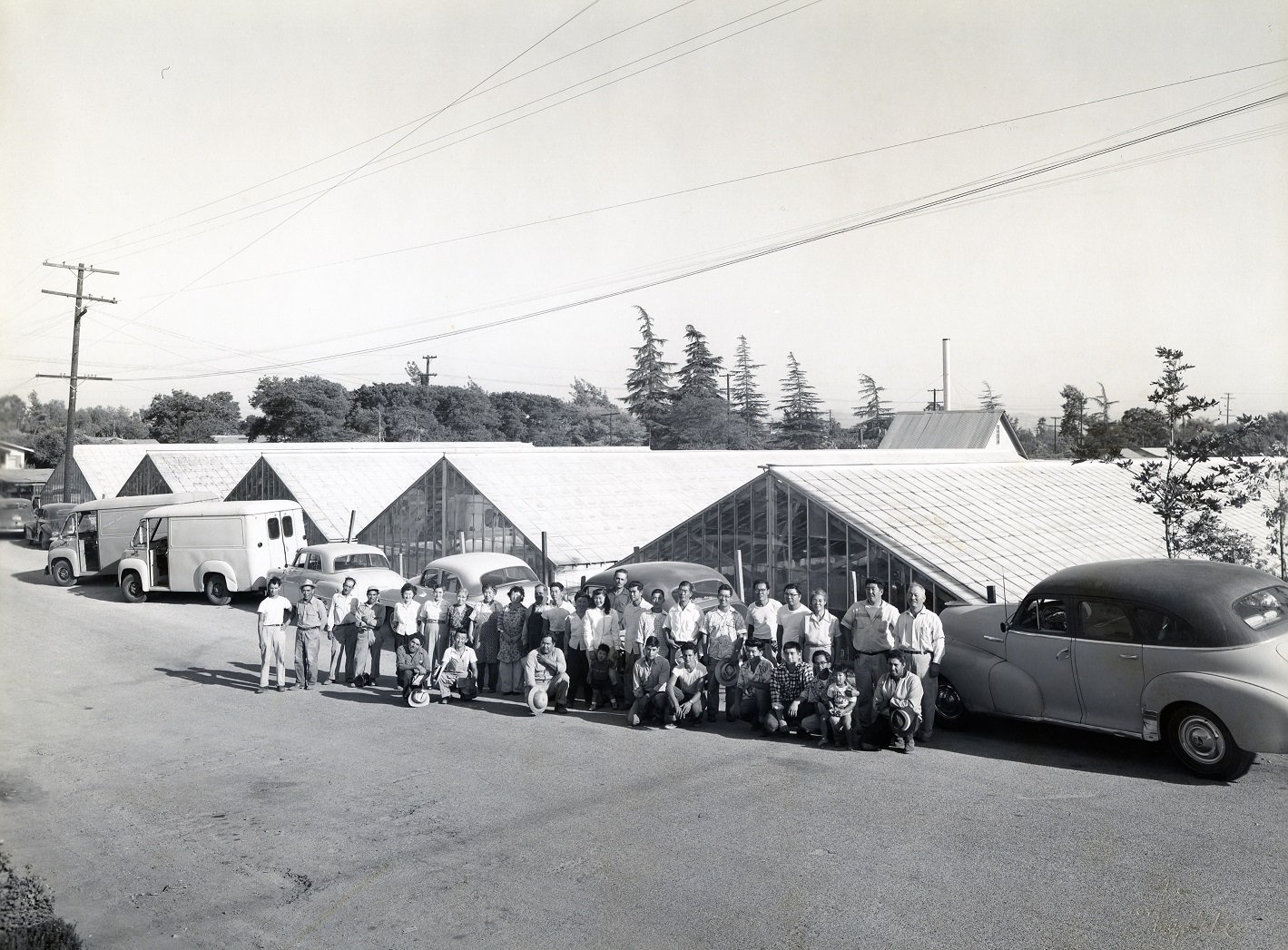
Photo Credit - Courtesy of Toyo Miyatake Studio
© SAN GABRIEL NURSERY & FLORIST – THE HISTORY
The company history written above was last updated in January 2007. Beginning in 2015, the owners of San Gabriel Nursery & Florist made the bittersweet decision to downsize our wholesale horticultural growing operations as some of the owners and key employees passed away and so that others could have the opportunity to retire or “partially” retire and have more time to spend with family and friends. The Monterey Park “Ranch” and San Gabriel greenhouses and growing grounds were sold and the wholesale sales stall at the flower market was closed. Maggie (our cashier and florist manager) and Diane fully retired a few years ago and Ishi only works five days a week now.
Ishi, Robert, Ben, Fred, Mary and Todd continue to operate our two-acre retail nursery, garden center and florist at 632 South San Gabriel Boulevard, San Gabriel and were honored to celebrate our 100th anniversary in 2023. We are grateful to have been a part of beautifying Southern California for over 100 years and we welcome you to come and see What’s Blooming Now?
